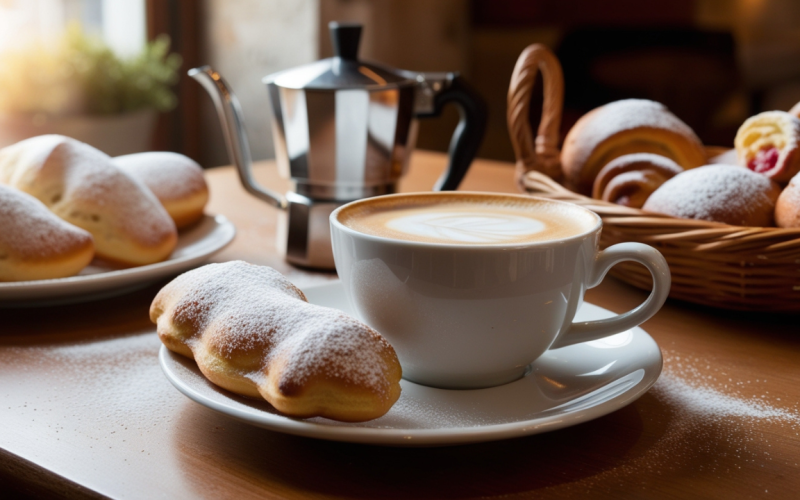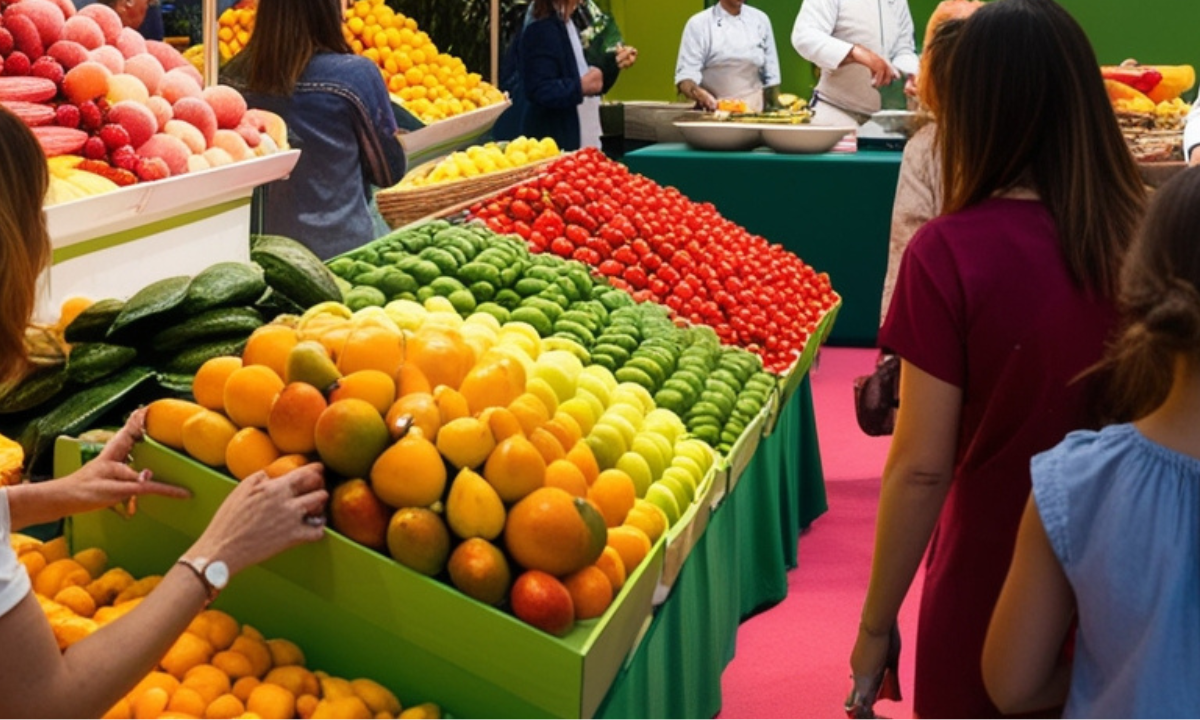Italian Breakfast Foods, Italian breakfasts embody a unique simplicity and tradition, blending minimalism with a focus on quality. Unlike the hearty breakfasts of America or England, Italian breakfasts are light yet satisfying, centring around fresh, local ingredients and emphasizing flavour over quantity.
Italian breakfast customs reflect a culture that values savouring the moment, whether at home or in a bustling café. This guide will take you through the ins and outs of an Italian breakfast, uncovering what Italians typically enjoy, the cultural nuances behind it, and how breakfast varies across different regions in Italy.
Key Takeaway
- Italian breakfast focuses on simplicity, typically featuring a coffee and pastry.
- Italians may enjoy breakfast at home, but many opt for a quick bite at a café (bar).
- Espresso and cappuccino are staple breakfast drinks, each with distinct preferences.
- Breakfast habits vary between Northern and Southern Italy due to local traditions and climate.
- While hotels offer expanded options, an authentic Italian breakfast remains light and sweet.
The Essentials of a Traditional Italian Breakfast
Coffee: The Heart of Italian Mornings
For Italians, coffee is more than just a beverage; it’s a ritualistic part of the morning routine, playing a central role in how they start their day. Coffee culture in Italy is unique, with specific rules and customs that distinguish it from coffee habits elsewhere. Italians value high-quality coffee served in small portions, and the experience is often enjoyed quickly and without frills.
How to Order Coffee in Italy
When ordering coffee in Italy, understanding the terminology can enhance your experience. Italians are very particular about their coffee, and there are specific times and places for each type:
- Espresso: The classic choice for most Italians. This small, concentrated shot of coffee is packed with flavor and energy, typically enjoyed quickly while standing at the café counter. Italians appreciate the bold, intense flavour of espresso and often drink it without milk.
- Cappuccino: Another favourite for Italian breakfasts, cappuccino combines espresso with steamed milk and a layer of foam. Italians generally drink cappuccino only in the morning, as the milk content is seen as too heavy for later in the day. Ordering a cappuccino after 11 a.m. is unusual in Italy, as milk-based coffees are considered more suitable for the morning.
Italian coffee culture is distinct, as many Italians view coffee as a quick pick-me-up rather than a prolonged experience. They may order and drink their coffee within minutes, often standing at the bar rather than sitting down. This efficiency is part of what makes Italian coffee culture unique and part of daily life for most Italians.
Difference Between Espresso and Cappuccino
Espresso and cappuccino serve different purposes in the Italian breakfast routine. Espresso is a quick, strong drink that Italians consume in a single gulp or a few sips, making it ideal for those needing a quick boost of energy.
Cappuccino, on the other hand, is creamier and often paired with a pastry, making it a more leisurely drink that Italians savor slowly. In Italy, the two drinks are not interchangeable, as each has its own moment and context within the day.
Cornetto and Pastries: Sweet Delights to Start the Day
Pastries are an essential part of the Italian breakfast experience, with cornetto being one of the most popular choices. Italian breakfasts typically lean towards sweet options, as this light yet satisfying approach suits the Italian palate. Cornetti (plural for cornetto) resemble croissants but have a unique Italian twist, offering a slightly sweeter flavor and softer texture.
Popular Cornetto Fillings
A cornetto is often filled with various flavors, making it a versatile pastry that appeals to many tastes. Common fillings include:
- Crema (Cream): A custard-like cream that adds richness and sweetness, often paired with a cappuccino for a balanced start to the morning.
- Marmellata (Jam): A fruity filling that adds a touch of freshness, commonly made with apricot or berry jam.
- Cioccolato (Chocolate): A decadent choice, especially popular among younger Italians and those with a sweet tooth.
Beyond Cornetto: Other Popular Pastries
While cornetto is the classic choice, other pastries frequently appear on Italian breakfast tables, adding variety and regional flair. Sfogliatella, a crispy, layered pastry filled with sweetened ricotta, is a favorite in Naples, while biscotti (crunchy, twice-baked cookies) are common throughout Italy and pair perfectly with coffee. Italians may also enjoy simpler options like bread with jam or honey, or even a slice of cake, keeping the focus on light, sweet flavors to ease into the day.
Breakfast Beverages in Italy
Coffee is King: Espresso, Cappuccino, and More
In Italy, coffee holds a unique place in the breakfast experience. Italians approach coffee with a sense of ritual, appreciating its bold flavors and the quick energy it provides. While espresso and cappuccino are the mainstays of Italian breakfast, coffee culture in Italy also includes a few other beverages, each with its place and preference.
Other Morning Drinks: Juices and Hot Chocolate
Although coffee dominates the Italian breakfast landscape, other drinks are available, especially for children or those who prefer a lighter option. Hot chocolate is a common choice for younger Italians, particularly during colder months.
Italian hot chocolate is typically rich and thick, offering a comforting alternative to coffee. Additionally, some Italians may enjoy a glass of freshly squeezed orange juice for a dose of vitamin C, though this is less common and usually seen as a health-conscious choice.
Traditional Coffee Pot in Italian Homes
At home, many Italians make their morning coffee with a moka pot, a stovetop coffee maker that produces strong, espresso-like coffee. The moka pot is an iconic piece of Italian culture, symbolizing the love Italians have for homemade coffee.
Using a moka pot allows Italians to prepare coffee in the comfort of their homes while still achieving the rich, aromatic flavor associated with Italian coffee. This homemade option is especially popular for families or individuals who enjoy breakfast at home.
Breakfast Foods in Northern vs. Southern Italy
Typical Breakfast Foods in Northern Italy
Breakfast traditions in Northern Italy tend to be lighter and more restrained, reflecting the cooler climate and the influence of neighboring European cuisines. Northern Italians often enjoy yogurt, fresh fruit, and bread with jam as part of a quick, healthy breakfast.
The northern regions are also known for their higher consumption of dairy, making yogurt a common choice. This lighter breakfast is not only nutritious but also complements the busier, faster-paced lifestyle often found in northern Italian cities.
Breakfast Foods of Southern Italy
In contrast, Southern Italy embraces a slightly more diverse approach to breakfast. Due to the warmer climate and rich culinary traditions, southern Italian breakfasts might include local specialties that reflect the region’s unique flavors.
For example, in Sicily, a popular summer breakfast is granita with brioche, a refreshing shaved ice dessert served with a soft, buttery roll. This combination is light yet satisfying, offering a cool start to the day, particularly during the hot months.
Differences Between Regions and Why They Matter
The regional differences in breakfast foods reflect the broader cultural and historical diversity across Italy. Northern Italian breakfasts, influenced by Central European flavors and customs, tend to be simple and efficient, ideal for a colder climate.
Southern Italian breakfasts, influenced by Mediterranean ingredients and traditions, offer a bit more variety, celebrating local produce and culinary heritage. These regional variations add depth to the Italian breakfast experience, giving visitors unique flavors to try based on where they are in Italy.
Popular Italian Breakfast Foods You Should Try
Sweet vs. Savory Breakfast Choices
Italian breakfasts are traditionally sweet, with pastries, cakes, and biscuits being the most common choices. However, some Italians enjoy savory items, particularly those from regions where cheese and cured meats are popular.
Sweet Choices: Pastries, Cakes, and Biscuits
Sweet breakfast items often include cakes, biscotti, and jam-filled pastries. These options provide a pleasant sweetness without being overly filling, setting a gentle tone for the rest of the day. Many Italians also enjoy a slice of homemade cake or biscotti with their coffee, especially when breakfast is enjoyed at home.
Savory Options for Breakfast in Italy
While savory breakfasts are less common, some Italians do enjoy savory items, particularly in regions like Puglia, where bread and cured meats are popular. In some cases, cheese and olives might be included, although this is rare and generally seen as more of a regional specialty than a nationwide habit.
Breakfast at Italian Homes vs. Cafés
Breakfast at home is usually kept simple, consisting of coffee and perhaps a slice of bread or a piece of fruit. In contrast, Italian cafés offer a broader selection, especially in pastries and specialty coffee drinks. Enjoying breakfast at a bar is a quintessential Italian experience, where you can mingle with locals and enjoy the vibrant atmosphere of a traditional Italian morning.
How Italians Enjoy Breakfast at Bars (Cafés)
Italian Bars and the Breakfast Experience
In Italy, bars (cafés) are more than just places to grab a quick drink; they’re an essential part of social life. Many Italians begin their day at a bar, standing at the counter with their coffee and pastry.
Unlike cafés in other countries, where people might linger over coffee for hours, Italian bars are designed for quick stops and brief interactions, creating a lively and efficient environment.
Social Aspect of Breakfast in Italian Bars
Breakfast at a bar is a social experience in Italy. Italians may bump into friends, chat with the barista, or simply enjoy the bustling atmosphere as they sip their espresso. This quick, communal breakfast moment reflects the Italian appreciation for connecting with others, even during short moments of the day. The bar experience gives breakfast a unique social dimension, making it an integral part of Italian culture.
Breakfast in Italian Hotels and Accommodations
What to Expect at Italian Hotels for Breakfast
In Italian hotels, breakfast options are often expanded to cater to international guests, providing more variety than a typical Italian breakfast. While a traditional Italian breakfast remains light, hotels frequently add items like eggs, toast, and fruit to accommodate the tastes of travelers who may be accustomed to heartier breakfasts.
Local Italian Breakfast Items Found in Hotels
For those wanting a more authentic experience, Italian hotels usually offer traditional breakfast items like espresso, cornetto, and biscotti. This mix allows guests to enjoy familiar foods while also getting a taste of local Italian breakfast culture.
How to Embrace Italian Breakfast Culture
Tips for Enjoying a True Italian Breakfast Experience
For those wanting to experience breakfast the Italian way, simplicity is key. Start your day with a cornetto and espresso at a local bar, savoring the flavors and embracing the quick, energetic atmosphere. Avoid overloading your breakfast with too many items; instead, focus on quality ingredients and fresh flavors.
Trying Italian Breakfasts at Home
If you’d like to recreate an Italian breakfast at home, consider investing in a moka pot to make authentic Italian coffee. Pair your coffee with a simple pastry, some yogurt, or a slice of bread and jam. This minimalist approach to breakfast can provide a taste of Italy, wherever you are.
Italian Breakfast vs. American Breakfast
Key Differences Between Italian and American Breakfasts
The Italian and American approaches to breakfast couldn’t be more different. Italian breakfasts are light, often limited to coffee and a pastry, while American breakfasts are known for being heartier, with dishes like eggs, bacon, and pancakes. The Italian preference for light, sweet breakfasts reflects a cultural approach to food that values balance and simplicity.
What to Expect When Ordering Breakfast in Italy
For travelers in Italy, understanding the local breakfast customs can enhance the experience. A typical breakfast will be small, and the options at most cafés will be limited to pastries and coffee. This simplicity may seem unusual to visitors accustomed to large breakfasts, but it offers a unique and refreshing way to start the day.
FAQs About Italian Breakfast Foods
1. Why is Italian breakfast typically light?
Italian breakfasts are traditionally light because Italians prefer to ease into the day with simple, easy-to-digest foods. The emphasis is on quality rather than quantity, with coffee and a small pastry providing a satisfying yet manageable start to the morning. Culturally, lunch is often the main meal of the day in Italy, so breakfast remains light and uncomplicated.
2. What is the difference between a cornetto and a croissant?
While a cornetto and a croissant look similar, they differ in taste and texture. Cornetto, the Italian version, is slightly sweeter and softer than a French croissant, with a more delicate crumb. Cornetti may also have various fillings, like cream, jam, or chocolate, making them a bit more versatile and often enjoyed as a sweet breakfast treat.
3. Can I get a savory breakfast in Italy?
Although Italian breakfasts are typically sweet, some savory options are available, especially in southern regions or in specific cafés. You might find items like bread with cheese or cured meats, but these are less common than sweet options. Hotels in Italy may also offer a wider selection of savory items, especially if they cater to international guests.
4. Is it common to order coffee with milk in the afternoon in Italy?
In Italy, milk-based coffees like cappuccino are usually reserved for the morning. Italians believe milk is best enjoyed early in the day, so ordering a cappuccino or other milk-based coffee after 11 a.m. is uncommon. In the afternoon, Italians typically switch to espresso, which is enjoyed quickly without milk.
My Opinion
Italian breakfasts reflect a culture that values quality over quantity. With a focus on coffee, pastries, and a quick, social experience, Italian breakfasts capture the essence of Italian life: savoring the simple pleasures, connecting with others, and starting the day with balance.
Whether you’re in Italy or recreating the experience at home, embracing the Italian approach to breakfast can offer a wonderful taste of Italian culture. Starting the day with a small, flavorful meal—shared in good company—captures the heart of Italy’s approach to food and life.







